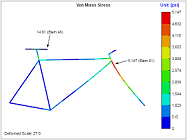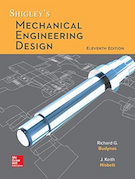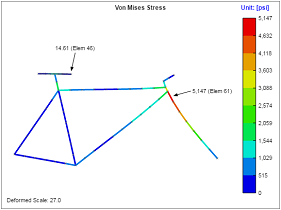Passing the PE Exam
Is a PE License Worthwhile?
A Professional Engineer (PE) license may or may not be a requirement depending on the type of engineering work that you perform, but it is always beneficial. As a mechanical engineer, the most likely situations that require a PE license are if you provide services directly to the public (this may be the case if you are a consultant or run a private practice), or if you work in the HVAC industry. However, even if you are not directly required to have a PE license, there are still many benefits to earning your license:
- Credentials: A PE license is a credential that indicates to employers and customers that you have a solid understanding of engineering fundamentals.
- Sharper Skills: After studying for the PE exam, you will sharpen skills in topics that you may not have seen in a while, and you will likely pick up a few tricks even in subjects that you see on a daily basis.
- Career Development: Once you start moving up into the higher ranks of a company, your credentials become more important for earning promotions. A PE license can be a key factor in determining a promotion (with a corresponding raise in salary).
- Independence: A PE license opens the door for you to become an independent consultant or to open a private practice. This can be invaluable in times of economic turmoil when the future is uncertain.
- Proposals: If you work for a company that bids on jobs, they will often list the engineers that will be working on it. Having Professional Engineers working the job lends additional credibility to the team and could help to win the proposal.
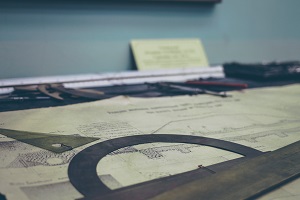
What is Involved in Earning a PE License?
The primary steps to earning a PE license are:
- Earn a bachelor's degree from an ABET-accredited program (some states do not require this).
- Successfully complete the Fundamentals of Engineering (FE) exam. After passing the FE exam, you will be an "engineer-in-training" (EIT).
- Gain approximately four years of relevant work experience. The required experience is dependent on your education level and varies from state to state.
- Successfully complete the Principles and Practice of Engineering (PE) exam.
After completing the above steps, you will be a Professional Engineer (PE) in the state in which you passed the exam. To check on your state's licensure requirements and to apply to take the PE exam, contact the appropriate state licensing board. Note that it is possible to be licensed in multiple states by applying for comity licensure.
PE Exam Details
The PE exam is an 8 hour test split into a 4 hour "breadth" exam in the morning and a 4 hour "depth" exam in the afternoon. There are 3 different mechanical engineering depth exams to choose from:
- Mechanical Systems and Materials (Machine Design)
- Thermal and Fluids Systems
- HVAC and Refrigeration
The depth exam will only include questions in the subject area selected from the list above. The breadth exam will include questions from all three subject areas.
There are 40 questions in each section for a total of 80 questions. You have an average of 6 minutes to complete each question. Every question is multiple choice with four possible answers.
NCEES publishes specifications on the topics covered in each exam and the approximate number of questions for each topic. The actual allocation of problems varies widely between exams, but these specifications give general guidelines on focus areas.
The PE exam is open book. You may bring any references that you like. The only exception is that your references must be bound -- loose-leaf papers are not permitted. Acceptable binding includes permanent binding (stitching or glue), 3-ring binders, spiral-bound notebooks, and brads. Although you may bring any references you like, you should only bring ones that you are familiar with. You will not have much time for searching aimlessly through books during the exam. There is a short list of references that we highly recommend to PE exam candidates toward the end of this page.
More information on exam policies and procedures can be found in the NCEES Examinee Guide.
We have a number of structural calculators to choose from. Here are just a few:
How to Study for the PE Exam
The best way to prepare for the PE exam is to work through as many practice problems as possible. You have an average of 6 minutes to complete each question, so speed is critical. The way to achieve the required speed is through consistent practice. Work the problems in the same way that you will be working them on the exam: with nothing but pencil, paper, calculator, and your reference books.
Most sources recommend studying for about 300 hours in preparation for the exam. This is a good starting point for planning your study schedule. How many hours will you have each week to study? Use that to determine when you should start studying. If you plan to study for 15 hours per week, then you'll need about 4.5 months to prepare. Most of this time should be spent solving practice problems.
Study the exam specification and be at least somewhat comfortable with every topic listed for both the breadth exam and the depth exam. Don't just focus on the topics that you're already comfortable with. Your best chance at succeeding is to be comfortable with all of the topics covered on the exam.
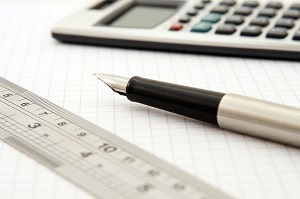
Consider purchasing the books from our recommended list. These two in particular should be purchased at the very beginning of your study effort:
- Lindeburg's Mechanical Engineering Reference Manual for the PE Exam (MERM). This is an incredibly comprehensive source of reference material.
- Lindeburg's Practice Problems for the Mechanical Engineering PE Exam. This book contains 851 practice problems, and is designed to be used with the Mechanical Engineering Reference Manual.
A good strategy is to select a chapter from Mechanical Engineering Reference Manual (listed above), skim it so that you are generally familiar with the layout and contents, and then work through the practice problems for that chapter from the Practice Problems book (listed above). The problems in this book are harder than those on the actual exam so don't worry if you can't solve them in 6 minutes. Just be consious of your time, and make sure that you consistently improve.
Create a reference binder full of useful equations, tables, and charts. As you work through practice problems, write down the equations that you use and keep them organized by topic so you can access them quickly. Continue adding to your reference binder as you work through practice problems, and eventually you will get to the point where you begin to rely on your binder as your primary reference. If you are diligent in the creation of this binder, it will serve you well on the exam and will continue to be a great reference for you throughout your career.
NCEES (the organization that creates, scores, and administers the PE exam) publishes a practice exam for each of the mechanical engineering sections. These practice exams are the closest thing you will find to the actual exam. The difficulty and formatting of the problems are very similar to those on the actual exam, so these practice exams are essential to any successful study plan. Purchase the practice exam for your chosen depth area, and then plan on allocating 8 hours one day to take it. Try to mimic the actual test conditions as closely as possible. Allow yourself only a calculator, some scratch paper, and a pencil. Take it in a library or some quiet area away from your home. Give yourself exactly 4 hours for the morning breadth section, followed by a 1 hour lunch break, followed by exactly 4 hours for the afternoon depth section. By mimicing the actual test conditions while taking this practice exam, you will learn a tremendous amount about your ability to perform on the actual exam. It would be a good idea to wait until somewhere around the halfway mark of your study plan before taking the practice exam. This way you will have had some good preparation before taking it, you will be able to use the exam results to guide the remainder of your studying.
NCEES determines a "cut score" for the actual exam, and this cut score is different for every exam based on the difficulty of the problems. However, a standard rule of thumb when grading your practice exam is to treat 70% as a passing score. It is definitely not exact, but if you can correctly answer 70% of the questions on the NCEES practice exam then you are in good shape.
When doing the practice problems, make sure to use the same calculator that you plan to use on the exam. You need to be comfortable with it, and you won't have time to fumble around with it on exam day. (Note that you are only permitted to use one of the calculators on NCEES's approved list).
Test-Taking Strategies
You will have about 6 minutes to complete each question. Bring a stopwatch to the exam to ensure that you maintain your pace. (Just be careful that the sound on your watch is turned off. You don't want any alarms going off during the exam.)
Skim each question before starting on any of them. Mark each question as a 1, 2, or 3. The 1s are the easy questions that you can do without having to look up the equations, or you know exactly where to find the equations you need. The 2s are moderate questions that you think you could do within about 6 minutes. The 3s are the tough questions that you're not sure whether you could finish in 6 minutes. Now start answering questions -- answer all the 1s first, followed by the 2s, and finally the 3s. All of the questions on the exam are worth 1 point, so you may as well get your points for the easy questions first (as well as build up your confidence), and then tackle the harder questions later.
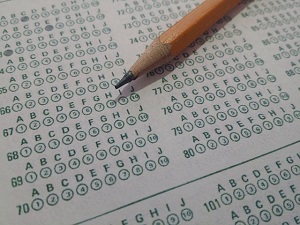
Take the time to read the problem carefully to make sure you're answering exactly what is being asked. Nothing is worse than wasting time answering something that wasn't actually asked.
Don't actually fill in the scantron until the last 10-15 minutes of the exam. Do all of your work in the provided booklet, and just circle your answers in the booklet. Save the scantron for the end. You're less likely to make a mistake this way, and it's more time efficient to fill in all the answers at once. This also gives you the option to amend your circled answers in the case that you finish early and have time to double-check your work.
You receive points for correct answers, but you don't receive negative points for incorrect answers. Make sure you put down an answer for every single question, and guess if you have to. Before guessing, use your engineering judgement to eliminate any obviously wrong answer choices.
If you are part-way through solving a question and you realize it's going to take you much longer than 6 minutes to complete it, scratch out the obviously wrong answers and move on. If you have time at the end you can circle back to this question, but you don't want to cheat yourself on the later questions that you may have a better shot at answering correctly.
We have a number of structural calculators to choose from. Here are just a few:
The Night Before the PE Exam
Make sure that you are prepared the night before the big day:
- Pack all of your things: confirmation letter for admittance, identification, books, 2 calculators, stopwatch, earplugs, and other assorted items.
- Get good sleep.
- Eat well -- avoid greasy or spicy foods.
- Make sure you have cash in your wallet for parking, vending machine, etc.
- If you live far away from the exam site, you may want to get a hotel room nearby to minimize travel time in the morning.
- Make sure your car is prepared: full gas tank, registration & proof of insurance in glove compartment, spare change for tolls & parking, good tire pressure, full fluid levels (oil, brakes, coolant, etc.), charged battery, no broken headlights or taillights
- Scope out the exam site so that you know what to expect. Where is the entrance? How is the parking situation? What is the commute like?
Books
These books are highly recommended to PE exam candidates. They will help in preparation for the exam and will serve as useful references during the exam itself.
Mechanical Engineering Reference Manual for the PE Exam, 13th Ed
This is the single most important book to purchase if your goal is to pass the PE exam. Not only is this book an incredible resource for the PE exam, it is also an excellent mechanical engineering handbook in general and will be useful to you for the rest of your career. This book covers the entire breadth of mechanical engineering, and so it condenses each topic into very few pages. Lindeburg does a great job of extracting the core ideas from each topic and then explaining them clearly and concisely. There is also a great section in the beginning of the book that goes into great detail on the particulars of the exam format, policies and procedures, and any other question you could possibly have regarding the PE exam.
Buy on AmazonPractice Problems for the Mechanical Engineering PE Exam, 13th Ed
The best way to study for the PE exam is to solve practice problems. This book contains 851 practice problems that are formatted just like the problems on the actual exam. Full solutions are also provided for each problem. The problems in this book are organized according to the corresponding chapters in the Mechanical Engineering Reference Manual (MERM), so they are perfect study companions.
Buy on AmazonMechanical PE Practice Examination, 3rd Edition
Although this book is intended to be used as a practice exam, these problems are harder (and so more time consuming) than the ones you will find on the exam. You can use this as a practice exam, but it may be best to treat it as a book of practice problems to solve at your leisure. This book has 4 sections in it: a breadth section, plus one section for each of the 3 major subject areas. You will find it worthwhile to solve all of the problems in this book.
Buy on AmazonPE Mechanical Engineering Practice Exam (NCEES)
NCEES (the organization that creates, scores, and administers the PE exam) publishes practice exams for each of the mechanical engineering sections. While the questions in these practice exam are obviously not the same questions you will encounter on the real exam, this is by far the most representative practice exam you will find anywhere. The difficulty and formatting of these problems are very much on par with the problems on the actual exam.
Quick Reference for the Mechanical Engineering PE Exam, 5th Ed
This book is essentially just Lindeburg's "Mechanical Engineering Reference Manual," but all of the words were removed and only the equations were kept. Not everyone will find this to be useful, but many people do.
Buy on AmazonOther Books
Other books that would be helpful to bring to the exam (and which may be of use in preparing for the exam) are given below. These books will be of primary use on the Mechanical Systems and Materials (Machine Design) depth exam:
- Budynas-Nisbett, "Shigley's Mechanical Engineering Design," 8th Edition
- Machinery's Handbook, 27th Ed., Industrial Press Inc., 2004.
- Mark's Standard Handbook for Mechanical Engineers, 11th Edition
- "Roark's Formulas for Stress and Strain," 8th Edition
Calculators
You can only use a calculator that is approved by NCEES. The official list can be found on the NCEES calculator policy page. Below are some good options that are NCEES approved. Note that you are allowed to bring a backup calculator in addition to your primary, and it is highly recommended that you do so (in case your primary runs out of batteries, stops working for some reason, or is stolen by another examinee).
TI-36X Pro
The TI-36X Pro is a great calculator, and it a good choice if you are already familiar with other TI calculators from school (such as the TI-83 or TI-89). One advantage of this calculator is MathPrint which shows math expressions and symbols as they would appear in a textbook.
Buy on AmazonCasio fx-115ES PLUS
This is a very similar calculator to the TI-36X Pro in terms of functionality, but with different navigation and feel.
Buy on AmazonHP 35s
The HP 35s supports both Reverse Polish Notation (RPN) and Algebraic entry. A huge advantage of this calculator over the others is that it is programmable.
Buy on AmazonSurvival List
Aside from books and calculators, these are a few items that will help significantly on your journey to passing the PE exam.
Timex Expedition Chronograph Analog-Digital Watch
A watch with a built-in stopwatch is an essential when preparing for and taking the PE exam. You also can't count on the exam room having a clock on the wall, which makes bringing a watch to the exam even more of a good idea. The Timex Expedition is dependable and reasonably priced. This model also has an attractive and durable leather band that fits in perfectly in a professional office setting.
Buy on AmazonEarplugs
You never know what the exam environment will be like. There could be construction right outside, or your neighbor could be coughing, fidgeting, or chewing gum the entire time. It's best to be prepared with earplugs.
Buy on AmazonPost-it Durable Index Tabs, 1 Inch
You will want to bookmark many of your most-referenced pages, and these Post-it tabs are great for that. They are durable with good adhesion. The adhesive portion of these tabs is also clear so they don't cover any text on the page.
You should check what kind of tabs your state board allows, because the requirements vary. These tabs work great, but in the worst case you could use Scotch tape to make them more permanent.
Buy on AmazonColor Rulers, 12 Inches, 4-Pack
A ruler is great to have as a straight edge for reading off of tables and charts, and it is also useful as a bookmark. When taking the exam, you may want to bookmark multiple pages, so having several rulers on hand can be a lifesaver.
Buy on AmazonStorage and Transport File Crate, 17.25 x 14.25 x 10.5 Inches
When it comes time to take the PE exam, you will need to transport your books, calculators, rulers, and other items into the exam room. Once you get to your table, this crate also doubles as a makeshift bookshelf.
Buy on AmazonOther Useful Items
- Large plastic garbage bags (to protect your books in case it's raining)
- Magnifying glass
- Advil or Tylenol for headache relief
- Tab dividers (for organizing your reference binder)
- Travel tissues
